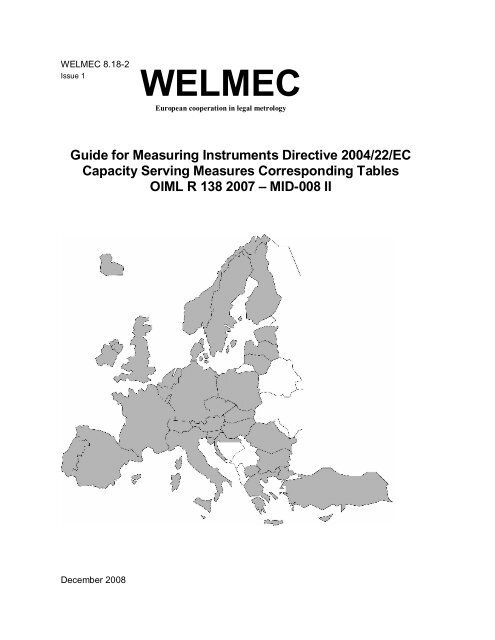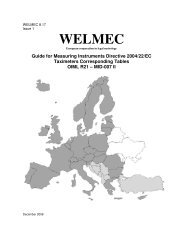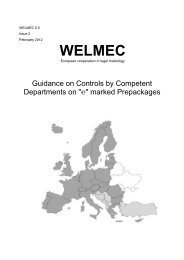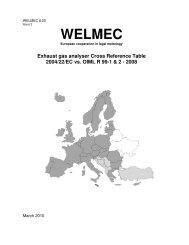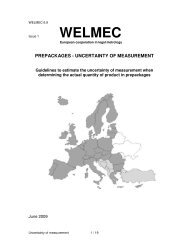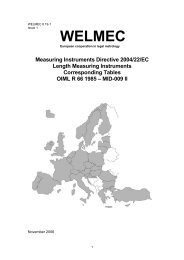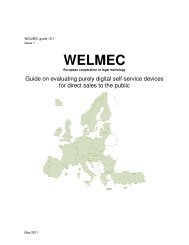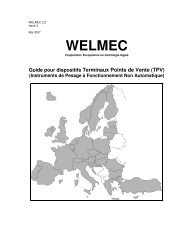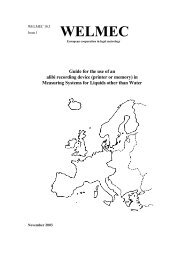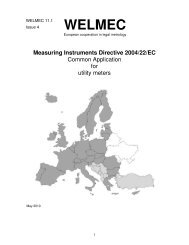Guide for Measuring Instruments Directive 2004/22/EC ... - WELMEC
Guide for Measuring Instruments Directive 2004/22/EC ... - WELMEC
Guide for Measuring Instruments Directive 2004/22/EC ... - WELMEC
- No tags were found...
You also want an ePaper? Increase the reach of your titles
YUMPU automatically turns print PDFs into web optimized ePapers that Google loves.
WELM<strong>EC</strong> 8.18-2Issue 1WELM<strong>EC</strong>European cooperation in legal metrology<strong>Guide</strong> <strong>for</strong> <strong>Measuring</strong> <strong>Instruments</strong> <strong>Directive</strong> <strong>2004</strong>/<strong>22</strong>/<strong>EC</strong>Capacity Serving Measures Corresponding TablesOIML R 138 2007 – MID-008 IIDecember 2008
WELM<strong>EC</strong>European cooperation in legal metrologyWELM<strong>EC</strong> is a co-operation between the legal metrology servicesof the Member States of the European Union and EFTA. Thisdocument is the introduction to WELM<strong>EC</strong>.WELM<strong>EC</strong> is publishing a number of <strong>Guide</strong>s to provide guidance tomanufacturers of measuring instruments and to notified bodiesresponsible <strong>for</strong> con<strong>for</strong>mity assessment of their products. The<strong>Guide</strong>s are purely advisory and do not themselves impose anyrestrictions or additional technical requirements beyond thosecontained in relevant <strong>EC</strong> <strong>Directive</strong>s. Alternative approaches maybe acceptable, but the guidance provided in these documents arerepresenting the considered view of WELM<strong>EC</strong> as to the bestpractice to be followed.Published by:WELM<strong>EC</strong> SecretariatBEVSchiffamtsgasse 1-3A-1020 ViennaAustriaTel: +43 1 211 10 2711Fax: +43 1 211 10 4701E-mail: welmec@bev.gv.atWebsite: www.welmec.org
Capacity serving measuresCross Reference Table <strong>2004</strong>/<strong>22</strong>/<strong>EC</strong> vs. OIML R 138: 2007Notes:1. The column “Comments” indicates when necessary the relevant text of OIML R 138 and related explanations concerning the compliance with relevantMID requirement.2. The column “Conclusion” gives the conclusion on the compliance between MID and OIML R 138 <strong>for</strong> the relevant requirement.The indication “Covered” means that:- the requirement of OIML R 138 is identical to the one of MID; or- the requirement of OIML R 138 is more severe than the one of MID; or- All the requirement of OIML R 138 fulfils MID requirements (even when MID allows other alternatives),- In case the requirement is not fully covered, a short statement explains what is covered.The indication “Not Covered” means that the MID requirement is either not compatible with the relevant OIML R 138 requirement or not included inOIML R 138.The indication “Not relevant” means that the MID Annex 1 requirement is not relevant <strong>for</strong> capacity serving measures.
<strong>Directive</strong> <strong>2004</strong>/<strong>22</strong>/<strong>EC</strong>Essential requirements of Annex Iand Annex MI-008 IIOIML R 138(2007)CommentsConclusionANNEX 11.1 Allowable ErrorsUnder rated operation conditions and inabsence of a disturbance, the error ofmeasurement shall not exceed themaximum permissible error (MPE) valueas laid down in the appropriateinstrument-specific requirements.Unless stated otherwise in theinstrument-specific annexes, MPE isexpressed as a bilateral value of thedeviation from the true measurementvalue.1.2 Under rated operating conditions and inpresence of a disturbance, theper<strong>for</strong>mance requirement shall be as laiddown in the appropriate instrumentspecificrequirements.5.1 CoveredNot relevantWhere the instrument is intended to beused in a specified permanentcontinuous electromagnetic field thepermitted per<strong>for</strong>mance during theradiated electromagnetic field-amplitudemodulated test shall be within MPE.1.3 The manufacturer shall specify theclimatic, mechanical and electromagneticenvironments in which the instrument isintended to be used, power supply andother influence quantities likely to affectNot relevant
<strong>Directive</strong> <strong>2004</strong>/<strong>22</strong>/<strong>EC</strong>Essential requirements of Annex Iand Annex MI-008 IIOIML R 138(2007)CommentsConclusion1.3.2 (a) Mechanical environments areclassified into classes M1 to M3 asdescribed belowM1: This class applies to instrumentsused in locations with vibration andshocks of low significance, e.g. <strong>for</strong>instruments fastened to light structuressubject to negligible vibrations andshocks transmitted from local blasting orpile-driving activities, slamming doors,etc.M2: This class applies to instrumentsused in locations with significant or highlevels of vibration and shock, e.g.transmitted from machines and passingvehicles in the vicinity or adjacent toheavy machines, conveyor belts, etc.M3: This class applies to instrumentsused in locations where the level ofvibration and shock is high and very high,e.g. <strong>for</strong> instruments mounted directly onmachines, conveyor belts, etc.Not relevant(b) The following influence quantitiesshall be considered in relation withmechanical environments:- Vibration- Mechanical shockNot relevant
<strong>Directive</strong> <strong>2004</strong>/<strong>22</strong>/<strong>EC</strong>Essential requirements of Annex Iand Annex MI-008 IIOIML R 138(2007)CommentsConclusion1.3.3 (a) Electromagnetic environments areclassified into E1, E2 or E3 as describedbelow, unless otherwise laid down in theappropriate instrument-specific annexes.E1: This class applies to instrumentsused in locations with electromagneticdisturbances corresponding to thoselikely to be found in residential,commercial and light industrial buildings.E2: This class applies to instrumentsused in locations with electromagneticdisturbances corresponding to thoselikely to be found in other industrialbuildings.E3: This class applies to instrumentssupplied by the battery of a vehicle. Suchinstruments shall comply with therequirements of E2 and the followingadditional requirements- voltage reductions caused byenergising the starter-motor circuits ofinternal combustion engines,- load dump transients occurring in theevent of a discharged battery beingdisconnected while the engine is running.Not relevant
<strong>Directive</strong> <strong>2004</strong>/<strong>22</strong>/<strong>EC</strong>Essential requirements of Annex Iand Annex MI-008 IIOIML R 138(2007)CommentsConclusion(b) The following influence quantitiesshall be considered in relation withelectromagnetic environments:- voltage interruptions- short voltage reductions- voltage transients on supply linesand/or signal lines- electrostatic discharges- radio frequency electromagnetic fields- conducted radio frequencyelectromagnetic fields on supply linesand/or signal lines- surges on supply lines and/or signallinesNot relevant1.3.4 Other influence quantities to beconsidered, where appropriate, are:- voltage variation- mains frequency variation- power frequency magnetic fields- any other quantity likely to influence in asignificant way the accuracy of theinstrument.Not relevant1.4 When carrying out the tests as envisagedin this <strong>Directive</strong>, the following paragraphsapply:
<strong>Directive</strong> <strong>2004</strong>/<strong>22</strong>/<strong>EC</strong>Essential requirements of Annex Iand Annex MI-008 IIOIML R 138(2007)CommentsConclusion1.4.1 Basic rules <strong>for</strong> testing and thedetermination of errorsEssential requirements specified in 1.1and 1.2 shall be verified <strong>for</strong> each relevantinfluence quantity. Unless otherwisespecified in the appropriate instrumentspecificannex, these essentialrequirements apply when each influencequantity is applied and its effectevaluated separately, all other influencequantities being kept relatively constantat their reference value.Metrological tests shall be carried outduring or after the application of theinfluence quantity, whichever conditioncorresponds to the normal operationalstatus of the instrument when thatinfluence quantity is likely to occur.Not relevant1.4.2 Ambient humidity- According to the climatic operatingenvironment in which the instrument isintended to be used either the dampheat-steady state (non-condensing) ordamp heat cyclic (condensing) test maybe appropriate.- The damp heat cyclic test is appropriatewhere condensation is important or whenpenetration of vapour will be acceleratedby the effect of breathing. In conditionswhere non-condensing humidity is afactor the damp-heat steady state isappropriate.Not relevant
<strong>Directive</strong> <strong>2004</strong>/<strong>22</strong>/<strong>EC</strong>Essential requirements of Annex Iand Annex MI-008 IIOIML R 138(2007)CommentsConclusion2 ReproducibilityThe application of the same measurandin a different location or by different user,all other conditions being the same, shallresult in the close agreement ofsuccessive measurements. Thedifference between the measurementresults shall be small when comparedwith the MPE.Not covered3 RepeatabilityThe application of the same measurandunder the same conditions ofmeasurement shall result in the closeagreement of successive measurements.The difference between themeasurement results shall be small whencompared with the MPE.Not covered4 Discrimination and sensitivityA measuring instrument shall besufficiently sensitive and thediscrimination threshold shall besufficiently low <strong>for</strong> the intendedmeasurement task.5 DurabilityA measuring instrument shall bedesigned to maintain an adequatestability of its metrological characteristicsover a period of time estimated by themanufacturer’s instruction when in theenvironmental conditions <strong>for</strong> which it isintended.4.4 “Vessels with gauge marks shall be so designed that at the nominalcapacity, a variation in the contents equal to the maximum permissibleerror causes a change in the liquid level of at least 2 mm.”4.2“The vessels shall be sufficiently robust to withstand normal usagewithout distortions.”CoveredCovered
<strong>Directive</strong> <strong>2004</strong>/<strong>22</strong>/<strong>EC</strong>Essential requirements of Annex Iand Annex MI-008 IIOIML R 138(2007)CommentsConclusion6 ReliabilityA measuring instrument shall bedesigned to reduce as far as possible theeffect of a defect that would lead to aninaccurate measurement result, unlessthe presence of such a defect is obvious.7 Suitability7.1 A measuring instrument shall have nofeature likely to facilitate fraudulent use,whereas possibilities <strong>for</strong> unintentionalmisuse shall be minimal.Not covered7.2 A measuring instrument shall be suitable<strong>for</strong> its intended use taking account of thepractical working conditions and shall notrequire unreasonable demands of theuser in order to obtain a correctmeasurement result.4.2“The vessels shall be sufficiently robust to withstand normal usagewithout distortions.For capacity serving measures and measuring container bottles, thematerials used in construction should be sufficiently tough, rigid, nonporous and stable to maintain accuracy during use.Vessels used only once, such as thin plastic or cardboard drinkingcapacities, must remain accurate during nominal filling, transportationand discharge functions.”Covered7.3 The errors of a utility measuringinstrument at flows or currents outsidethe controlled range shall not be undulybiased.Not relevant7.4 Where a measuring instrument isdesigned <strong>for</strong> the measurement of valuesof the measurand that are constant overtime, the measuring instrument shall beinsensitive to small fluctuations of thevalue of the measurand, or shall takeNot relevant
<strong>Directive</strong> <strong>2004</strong>/<strong>22</strong>/<strong>EC</strong>Essential requirements of Annex Iand Annex MI-008 IIappropriate action.7.5 A measuring instrument shall be robustand its materials of construction shall besuitable <strong>for</strong> the conditions in which it isintended to be used.7.6 A measuring instrument shall bedesigned so as to allow the control of themeasuring tasks after the instrument hasbeen placed on the market and put intouse. If necessary, special equipment orsoftware <strong>for</strong> this control shall be part ofthe instrument. The test procedure shallbe described in the operation manual.When a measuring instrument hasassociated software which provides otherfunctions besides the measuringfunction, the software that is critical <strong>for</strong>the metrological characteristics shall beidentifiable and shall not be inadmissiblyinfluenced by the associated software.8 Protection against corruptionOIML R 138(2007)Comments4.2 “The vessels shall be sufficiently robust to withstand normal usagewithout distortions.”ConclusionCoveredNot relevant8.1 The metrological characteristics of ameasuring instrument shall not beinfluenced in any inadmissible way by theconnection to it of another device, by anyfeature of the connected device itself orby any remote device that communicateswith the measuring instrument.Not relevant
<strong>Directive</strong> <strong>2004</strong>/<strong>22</strong>/<strong>EC</strong>Essential requirements of Annex Iand Annex MI-008 IIOIML R 138(2007)CommentsConclusion8.2 A hardware component that is critical <strong>for</strong>metrological characteristics shall bedesigned so that it can be secured.Security measures <strong>for</strong>eseen shall provide<strong>for</strong> evidence of an intervention.Not relevant8.3 Software that is critical <strong>for</strong> metrologicalcharacteristics shall be identified as suchand shall be secured.Software identification shall be easilyprovided by the measuring instrument.Evidence of an intervention shall beavailable <strong>for</strong> a reasonable period of time.Not relevant8.4 Measurement data, software that iscritical <strong>for</strong> measurement characteristicsand metrologically important parametersstored or transmitted shall be adequatelyprotected against accidental orintentional corruption.Not relevant8.5 For utility measuring instruments thedisplay of the total quantity supplied orthe displays from which the total quantitysupplied can be derived, whole or partialreference to which is the basis <strong>for</strong>payment, shall not be able to be resetduring use.Not relevant9 In<strong>for</strong>mation to be borne by and toaccompany the instrument
<strong>Directive</strong> <strong>2004</strong>/<strong>22</strong>/<strong>EC</strong>Essential requirements of Annex Iand Annex MI-008 IIOIML R 138(2007)CommentsConclusion9.1 A measuring instrument shall bear thefollowing inscriptions:- manufacturer’s mark or name- in<strong>for</strong>mation in respect of its accuracy, (1)plus, when applicable- in<strong>for</strong>mation in respect of the conditionsof use- measuring capacity- measuring range- identity marking- number of <strong>EC</strong>-type examinationcertificate or the <strong>EC</strong> design examinationcertificate- in<strong>for</strong>mation whether or not additionaldevices providing metrological resultscomply with the provisions of this<strong>Directive</strong> on legal metrological control.5.2.45.2.15.2.5Every vessel <strong>for</strong> commercial transactions shall bear a mark identifyingthe company responsible <strong>for</strong> compliance with the metrologicalspecifications applicable to the vessel.Every vessel <strong>for</strong> commercial transactions shall bear a clearly visible,easily readable and permanent indication of the nominal capacity V n .Markings shall be in SI units.If the National Metrology Authority decides on a reference temperatureother than 20 °C, this temperature must be indicated next to everyvolume indication affixed to the vessel. (2)(1) Not required (see preamble to MI-008 II)(2) 1.1 of MI-008’ Chapter II requires a reference temperature of 20 °CCovered when thereference temperatureis 20 °CCovered however see9.79.2 An instrument of dimensions too small orof too sensitive a composition to allow itto bear the relevant in<strong>for</strong>mation shallhave its packaging, if any, and theaccompanying documents required bythe provisions of this <strong>Directive</strong> suitablymarked.Not relevant9.3 The instrument shall be accompanied byin<strong>for</strong>mation on its operation, unless thesimplicity of the measuring instrumentmakes this unnecessary. In<strong>for</strong>mationshall be easily understandable and shallinclude where relevant:- rated operating conditions- mechanical and electromagneticNot relevant
<strong>Directive</strong> <strong>2004</strong>/<strong>22</strong>/<strong>EC</strong>Essential requirements of Annex Iand Annex MI-008 IIOIML R 138(2007)CommentsConclusionenvironment classes- the upper and lower temperature limit,whether condensation is possible or not,open or closed location- instructions <strong>for</strong> installation,maintenance, repairs, permissibleadjustments- instructions <strong>for</strong> correct operation andany special conditions use- conditions <strong>for</strong> compatibility withinterfaces, sub-assemblies or measuringinstruments.9.4 Groups of identical measuringinstruments used in the same location orused <strong>for</strong> utility measurements do notnecessarily require individual instructionmanuals.Capacity serving measures do not need user manual to be utilized.Not relevant9.5 Unless specified otherwise in aninstrument-specific annex, the scaleinterval <strong>for</strong> a measured value shall be inthe <strong>for</strong>m 1x10 n , 2x10 n , or 5x10 n , where nis any integer or zero. The unit ofmeasurement or its symbol shall beshown close to the numerical value.Capacity serving measures do not have scale intervals.Not relevant9.6 A material measure shall be marked witha nominal value or a scale, accompaniedby the unit of measurement used.5.2.1“Every vessel <strong>for</strong> commercial transactions shall bear a clearly visible,easily readable and permanent indication of the nominal capacity Vn.Markings shall be in SI units.”Covered however see9.79.7 The units of measurement used and theirsymbols shall be in accordance with theprovisions of Community legislation onunits of measurement and their symbols.3“The units of measurement shall be the SI units.” Imperial units notcovered.Covered when unitsare SI
<strong>Directive</strong> <strong>2004</strong>/<strong>22</strong>/<strong>EC</strong>Essential requirements of Annex Iand Annex MI-008 IIOIML R 138(2007)CommentsConclusion9.8 All marks and inscriptions required underany requirement shall be clear, nonerasable,unambiguous and nontransferable.5.2.1“Every vessel <strong>for</strong> commercial transactions shall bear a clearly visible,easily readable and permanent indication of the nominal capacity Vn.Markings shall be in SI units.”The Non transferability requirement is not referred to in the OIML R138. It is considered to be met by the requirement that the indicationshould be permanent.Covered however see9.710 Indication of result10.1 Indication of the result shall be by meansof a display or a hard copy.Not relevant10.2 The indication of any result shall be clearand unambiguous and accompanied bysuch marks and inscriptions necessary toin<strong>for</strong>m the user of the significance of theresult. Easy reading of the present resultshall be permitted under normalconditions of use. Additional indicationsmay be shown provided they cannot beconfused with the metrologicallycontrolled indications.5.2.1“Every vessel <strong>for</strong> commercial transactions shall bear a clearly visible,easily readable and permanent indication of the nominal capacity Vn.Markings shall be in SI units.”Covered however see9.710.3 In the case of hard copy the print orrecord shall also be easily legible andnon-erasable.Not relevant10.4 A measuring instrument <strong>for</strong> direct salestrading transactions shall be designed topresent the measurement result to bothparties in the transaction when installedas intended. When critical in case ofdirect sales, any ticket provided to theconsumer by an ancillary device notNot relevant
<strong>Directive</strong> <strong>2004</strong>/<strong>22</strong>/<strong>EC</strong>Essential requirements of Annex Iand Annex MI-008 IIOIML R 138(2007)CommentsConclusioncomplying with the appropriaterequirements of this <strong>Directive</strong> shall bearan appropriate restrictive in<strong>for</strong>mation.10.5 Whether or not a measuring instrumentintended <strong>for</strong> utility measurementpurposes can be remotely read it shall inany case be fitted with a metrologicallycontrolled display accessible withouttools to the customer. The reading of thisdisplay is the measurement result thatserves as the basis <strong>for</strong> the price to pay.Not relevant11 Further processing of data to concludethe trading transaction11.1 A measuring instrument other than autility measuring instrument shall recordby a durable means the measurementresult accompanied by in<strong>for</strong>mation toidentify the particular transaction, when:- the measurement is non-repeatable- the measuring instrument is normallyintended <strong>for</strong> use in the absence of one ofthe trading parties.Not relevant11.2 Additionally, a durable proof of themeasurement result and the in<strong>for</strong>mationto identify the transaction shall beavailable on request at the time themeasurement is concluded.Not relevant12 Con<strong>for</strong>mity evaluationA measuring instrument shall beIt is achieved by complying to OIML R 138Covered
<strong>Directive</strong> <strong>2004</strong>/<strong>22</strong>/<strong>EC</strong>Essential requirements of Annex Iand Annex MI-008 IIOIML R 138(2007)CommentsConclusiondesigned so as to allow ready evaluationof its con<strong>for</strong>mity with the appropriaterequirements of this <strong>Directive</strong>.ANNEX MI-008 CHAPTER IIThe relevant essential requirements ofAnnex I, and the specific requirementsand the con<strong>for</strong>mity assessmentprocedures listed in this chapter, apply tocapacity serving measures definedbelow. However, the requirement <strong>for</strong> thesupply of a copy of declarations ofcon<strong>for</strong>mity may be interpreted asapplying to a batch or consignmentrather than each individual instrument.Also, the requirement <strong>for</strong> the instrumentto bear in<strong>for</strong>mation in respect of itsaccuracy shall not applyDefinitionsCapacity serving measureA capacity measure (such as a drinkingglass, jug or thimble measure) designedto determine a specified volume of aliquid (other than a pharmaceuticalproduct) which is sold <strong>for</strong> immediateconsumption.2.2“Measures which are filled as required and used <strong>for</strong> the retail sale ofdrinks sold by volume. They are divided into two categories: transfermeasures used solely <strong>for</strong> decanting specific volumes of beverages anddrinking measures used also <strong>for</strong> the consumption of specific volumes ofbeverages.”Covered
<strong>Directive</strong> <strong>2004</strong>/<strong>22</strong>/<strong>EC</strong>Essential requirements of Annex Iand Annex MI-008 IIOIML R 138(2007)CommentsConclusionLine measureA capacity serving measure marked witha line to indicate nominal capacity.2.9“Gauge markMark, generally a line that indicates the nominal capacity”Covered when gaugemark in a lineBrim measureA capacity serving measure <strong>for</strong> which theinternal volume is equal to the nominalcapacity.2.7 “Brim capacity, VrVolume that the vessel is meant to contain when filled to the brim.”CoveredTransfer measureA capacity serving measure from which itis intended that the liquid is decantedprior to consumption.2.2“Measures which are filled as required and used <strong>for</strong> the retail sale ofdrinks sold by volume. They are divided into two categories: transfermeasures used solely <strong>for</strong> decanting specific volumes of beverages anddrinking measures used also <strong>for</strong> the consumption of specific volumes ofbeverages.”CoveredCapacityThe capacity is the internal volume <strong>for</strong>brim measures or internal volume to afilling mark <strong>for</strong> line measures.2.52.7“Nominal capacity, VnVolume indicated on the vessel.”“Brim capacity, VrVolume that the vessel is meant to contain when filled to the brim.”Covered2.9“Gauge markMark, generally a line that indicates the nominal capacity”4.6.1Vessels with gauge marks“Filled to the gauge mark” is when the lowest part of the meniscus<strong>for</strong>med by the liquid is tangential to the upper edge of the gauge mark.1 Reference Conditions
<strong>Directive</strong> <strong>2004</strong>/<strong>22</strong>/<strong>EC</strong>Essential requirements of Annex Iand Annex MI-008 IIOIML R 138(2007)CommentsConclusion1.1 Temperature: the reference temperature<strong>for</strong> measurement of capacity is 20 °C.5.2.5“Reference temperature If the national authority <strong>for</strong> metrology decideson a reference temperature other than 20 °C, this temperature must beindicated next to every volume indication affixed on the vessel.”Covered when thereference temperatureis 20 o C1.2 Position <strong>for</strong> correct indication: freestanding on a level surface.2 MPEs4.55.1.1/4.1.1“Vertical positionVessels with gauge marks and measuring container bottles shall havea base wide enough to allow a vertical, stable position when resting ona flat horizontal surface. If not, the holder must be provided with thevessel..”Exactly the same MPE. Nominal capacity limited by <strong>for</strong>mula.CoveredCoveredTable 1Capacity Line BrimNote: For brim measures the ‘+’ sign indicates that the measurecontains at least the brim capacity, Vr up to a maximum of Vr + MPE.Transfermeasures< 100 ml ± 2 ml – 0+ 4 ml≥100 ml ± 3 % – 0+ 6 %Servingmeasures< 200 ml ± 5 % – 0+ 10 %≥200 ml ± (5 ml+ 2,5%)3 Materials4 Shape– 0+ 10 ml + 5 %Capacity serving measures shall bemade of material which is sufficientlyrigid and dimensionally stable to maintaincapacity within the MPE.4.2 “The vessels shall be sufficiently robust to withstand normal usagewithout distortions. For capacity serving measures and measuringcontainer bottles, the materials used in construction should besufficiently tough, rigid, non porous and stable to maintain accuracyduring use.”Covered
<strong>Directive</strong> <strong>2004</strong>/<strong>22</strong>/<strong>EC</strong>Essential requirements of Annex Iand Annex MI-008 IIOIML R 138(2007)CommentsConclusion4.1 Transfer measures shall be designed sothat a change of contents equal to theMPE causes a change in level of at least2 mm at the brim or filling mark.4.4“Vessels with gauge marks shall be so designed that at the nominalcapacity, a variation in the contents equal to the maximum permissibleerror, causes a change in the liquid level of at least 2 mm.”Brim are not considered in OIML R 138Covered4.2 Transfer measures shall be designed sothat the complete discharge of the liquidbeing measured will not be impeded.No such requirement in OIML R 138Not covered5 Marking5.1 The nominal capacity declared shall beclearly and indelibly marked on themeasure.5.2.1 “Nominal capacityEvery vessel <strong>for</strong> commercial transactions shall bear a clearly visible,easily readable and permanent indication of the nominal capacity V n .Markings shall be in SI units.”Covered however see9.7 (Annex I)5.2 Capacity serving measures may also bemarked with up to three clearlydistinguishable capacities, none of whichshall lead to confusion one to the other.5.2.2“In addition to the requirements of 7.2.1, capacity serving measuresshall bear at least one filling mark.”OIML R 138 does not limit the number of mark to 3 (at least one…).Covered when thereare no more than 3capacities marked5.3 All filling marks shall be sufficiently clearand durable to ensure that MPEs are notexceeded in use.4.2“The vessels shall be sufficiently robust to withstand normal usagewithout distortions.For capacity serving measures and measuring container bottles, thematerials used in construction should be sufficiently tough, rigid, nonporous and stable to maintain accuracy during use.”Covered5.2.2“All filling marks shall be clearly visible and permanently marked.”


